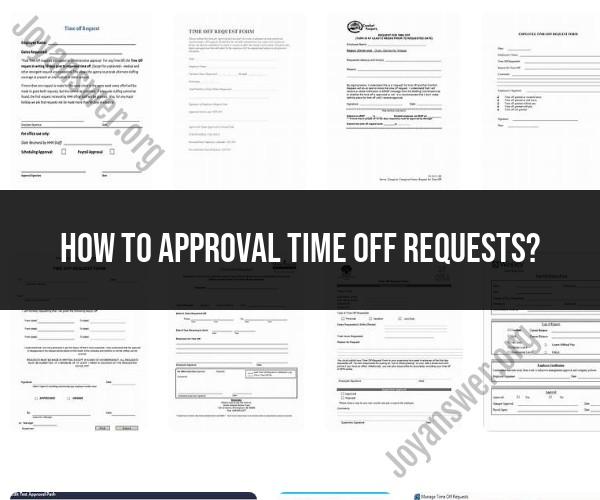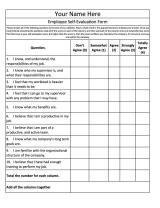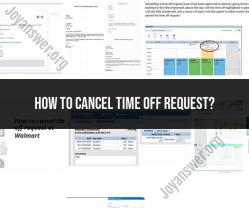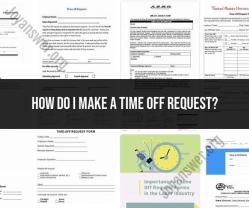How to approval time off requests?
The process for approving time off requests as a manager typically involves several steps to ensure proper scheduling and coverage while accommodating employee needs. Here's a guide on how to approve time off requests:
Review Company Policies: Familiarize yourself with your company's time off policies and procedures. These policies should outline the process for submitting and approving time off requests, as well as any specific guidelines regarding notice periods, maximum concurrent leaves, and blackout dates.
Receive the Time Off Request: When an employee submits a time off request, review the request promptly. Most requests are submitted electronically through HR software or scheduling tools, but some employees may submit them in person or via email. Ensure you have all the necessary details, including the dates requested, the reason for the request, and any other relevant information.
Check Scheduling and Coverage: Examine your team's current schedule to assess the impact of the requested time off. Consider factors like workload, deadlines, and the availability of other team members. Ensure that approving the request won't leave the team shorthanded or jeopardize project timelines.
Verify Available Leave Balances: Check the employee's available paid time off balances to confirm that they have enough accrued leave to cover their requested time off. If they don't, you may need to discuss options with the employee, such as unpaid leave or rescheduling.
Assess Prioritization: If multiple employees have submitted time off requests for the same period, evaluate the requests based on factors such as seniority, the timing of the requests, and the nature of the reasons. Be fair and consistent in your decision-making.
Communication with the Employee: Contact the requesting employee to discuss their request if necessary. This can be especially important if there are scheduling conflicts or if further clarification is needed. Keep the lines of communication open and transparent.
Approve or Deny the Request: Make a decision to either approve or deny the time off request based on your assessment of the situation. If the request is approved, specify the dates and any conditions or expectations for the time off.
Notify the Employee: Notify the employee of your decision promptly. This can be done through the same channel the request was submitted (e.g., HR software, email, or in person). Be clear and concise in your communication, and provide any additional information they may need.
Update Scheduling and Records: Make the necessary updates to your team's schedule and attendance records to reflect the approved time off. Ensure that other team members are aware of the changes.
Document the Approval: Keep records of the approved time off requests, including dates, reasons, and any conditions or agreements made with the employee. This documentation is essential for tracking and compliance purposes.
Handle Any Reassignments: If the employee's absence requires redistributing tasks or responsibilities, make those reassignments as needed. Ensure that other team members are aware of their new roles and responsibilities during the absence.
Monitor and Follow Up: During the employee's absence, monitor the team's performance and address any issues that may arise. Encourage open communication among team members to ensure a smooth workflow.
Remember that the process may vary depending on your company's specific policies and practices. Effective communication and a fair and consistent approach to approving time off requests are key to maintaining a positive working relationship with your team while ensuring that business operations run smoothly.
Approving Time Off Requests: Employer Responsibilities
As an employer, you have a responsibility to approve time off requests in a fair and equitable manner. You should also be aware of any applicable laws and regulations that may govern time off requests.
Here are some tips for approving time off requests:
- Have a clear and concise time off policy in place. Your time off policy should outline the different types of time off that are available to employees, as well as the procedures for requesting and approving time off.
- Consider the needs of both the employee and the business. When approving time off requests, you should consider the needs of both the employee and the business. Make sure that you are able to staff appropriately and that the employee's absence will not have a negative impact on the business.
- Be fair and consistent. Be sure to approve time off requests in a fair and consistent manner. Avoid giving preferential treatment to certain employees.
- Communicate your decision to the employee in a timely manner. Once you have made a decision on a time off request, be sure to communicate your decision to the employee in a timely manner.
The Role of Supervisors: Handling Time Off Requests
Supervisors play an important role in handling time off requests. They are responsible for reviewing requests and making recommendations to their managers.
Here are some tips for supervisors when handling time off requests:
- Be familiar with the company's time off policy. Make sure that you are familiar with the company's time off policy and that you understand the different types of time off that are available to employees.
- Review requests promptly. Review time off requests as soon as possible and make recommendations to your manager.
- Be fair and consistent. Be sure to review requests in a fair and consistent manner. Avoid giving preferential treatment to certain employees.
- Communicate with your manager and the employee. Keep your manager informed of all time off requests and communicate your recommendations to them. Once the manager has made a decision, communicate the decision to the employee in a timely manner.
Streamlining Time Off Approvals: Best Practices for Employers
There are a number of things that employers can do to streamline the time off approval process. Here are some best practices:
- Use a time off request system. A time off request system can help to streamline the approval process by automating many of the tasks involved. For example, a time off request system can automatically notify supervisors and managers of requests, track the status of requests, and generate reports.
- Set clear deadlines for approving requests. Set clear deadlines for approving time off requests. This will help to ensure that requests are processed in a timely manner.
- Empower supervisors to approve certain types of requests. You can empower supervisors to approve certain types of time off requests, such as vacation days and sick days. This can help to reduce the burden on managers and speed up the approval process.
- Be flexible. Be flexible when approving time off requests. If possible, try to accommodate employees' requests.
By following these best practices, employers can streamline the time off approval process and make it easier for employees to request and receive time off.












